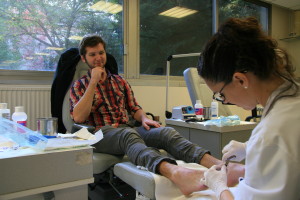Of all the areas of the body most affected by the deadly habit of smoking the most visible effects can be seen on our skin. Tobacco smoke causes oxidative stress so that insufficient oxygen is supplied to the skin resulting in tissue ischaemia (an inadequate blood supply to an organ or part of the body) and blood vessel occlusion. It reduces innate and host immune responses, and induces an enzyme that specifically degrades collagen.
Nicotine from cigarettes induces vasoconstriction, inhibits inflammation, delays wound healing and accelerates skin aging. Tobacco smoking has unpleasant temporary dermal and mucosal effects including wrinkles, temporary yellowing of fingers and fingernails and discolored teeth. Smokers tend to be more severely affected than non-smokers by the majority of inflammatory skin diseases — even acne —and various conditions are often more difficult to treat effectively in smokers.
Longer term, the gaunt skin of a 40-year-old heavy smoker resembles that of a non-smoking 70-year-old. Smokers can look forward to facial wrinkles and furrows (crows’ feet), vertical ear crease, smoker’s lines around the lips, and baggy eyelids with a slack jawline. What is more, you will likely experience uneven skin coloring, exhibiting greyish, yellow skin tones with prominent blood vessels. All this in addition to generally dry, coarse skin.
Smoking causes biomechanical changes in our bodies that can speed up the normal aging process of the skin, contributing to deep wrinkles and fine lines that make us look older. The more cigarettes you smoke and the longer you smoke, the more wrinkled, leathery skin you will develop. If you smoke and want to quit there are many resources at your disposal. Talk to your doctor about smoking cessation solutions.
And of course the skin has the risk of cancer that all bodily systems endure. Smoking cigarettes doubles the risk of developing a type of skin cancer called squamous cell carcinoma, compared to non-smokers. There is also an increased risk of oral leukoplakia (precancer) and oral cancer; 75% of cases of oral cancer and lip cancer occur in smokers.
There is never a wrong time to quit smoking. If you smoke, quitting smoking is the most important step you can take to protect your lungs, heart, brain and of course your skin. It is never too late to quit. Your doctor can help you decide which smoking cessation method will work best for you.
Our Dermatology department specializes in diagnosing, treating and preventing skin conditions, diseases and cancers. The Dermatology & Aesthetic Center also houses our in-house pathology lab.
Dr. Kenneth Wallace III, M.D. is our Board Certified Dermatologist as well as a Mohs’ Skin Cancer Surgeon.


































